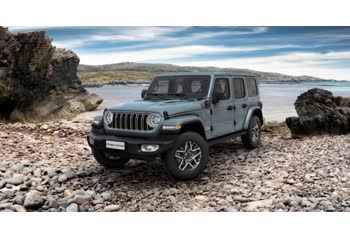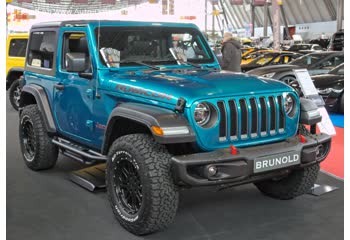Jeep Wrangler 2018 - Sport 3.0 EcoDiesel V6 (260 Hp) 4x4 Automatic specifications
Overview
What is the engine capacity of a Jeep Wrangler 2018?
The engine capacity of the Jeep Wrangler 2018 is 2987 cm.
Jeep Wrangler 2018 How many horsepower?
The engine power of the Jeep Wrangler 2018 is 260 Hp @ 3600 rpm..
What is the Jeep Wrangler 2018 engine?
Jeep Wrangler 2018 engine is EXJ. (Click to see other cars using the same engine)
How much gasoline does a Jeep Wrangler 2018 consume?
The Jeep Wrangler 2018 consumes 9.4 liters of gasoline per 100 km
What is the recommended oil for a Jeep Wrangler 2018 engine?
The recommended oil for a Jeep Wrangler 2018 car engine is 5W-40.
What type of camshaft transmission system is used in a Jeep Wrangler 2018 engine?
chain is used to transmit motion.
General:
Brand
Jeep
Model
Wrangler
Generation
Wrangler IV Unlimited (JL)
Modification (Engine)
Sport 3.0 EcoDiesel V6 (260 Hp) 4x4 Automatic
Start of production
January, 2018
End of production
November, 2022
Powertrain Architecture
Internal Combustion engine
Body type
Off-road vehicle
Seats
5
Doors
4
Engine:
Engine systems
Start & Stop System
Power
260 hp @ 3600 rpm.
Power per litre
87 hp/l
Torque
600 nm @ 1400-2800 rpm.
Engine Model/Code
Engine displacement
2987 cm
Number of cylinders
6
Engine configuration
V-engine
Number of valves per cylinder
4
Fuel injection system
Diesel Commonrail
Engine aspiration
Turbocharger, Intercooler
Valvetrain
DOHC
Engine oil capacity
8.5 l
Coolant
11.6 l
Engine layout
Front, Longitudinal
Cylinder Bore
83 mm
Piston Stroke
92 mm
Compression ratio
16
Maximum engine speed
4600 rpm.
recommended engine oil
5W-40
euro standards
EURO 6
engine lifespan (km)
~250 000
weight (kg)
220
timing drive
chain
Show more details about this engine
Performance:
Fuel Type
Diesel
Fuel consumption (economy) - urban
10.7 l/100 km
Fuel consumption (economy) - extra urban
8.1 l/100 km
Fuel consumption (economy) - urban (EPA)
10.7 l/100 km
Fuel consumption (economy) - extra urban (EPA)
8.1 l/100 km
Fuel consumption (economy) - combined (EPA)
9.4 l/100 km
Fuel consumption (economy) - combined
9.4 l/100 km
Weight-to-power ratio
8.1 kg/Hp, 123.2 Hp/tonne
Weight-to-torque ratio
3.5 kg/Nm, 284.2 Nm/tonne
Size and space:
Kerb Weight
2111 kg
Max. weight
2626 kg
Max load
515 kg
Trunk (boot) space - maximum
1059 l
Trunk (boot) space - minimum
548 l
Permitted trailer load with brakes (12%)
1588 kg
Fuel tank capacity
69 l
Dimensions:
Ramp-over (brakeover) angle
20.3°
Length
4785 mm
Width
1875 mm
Height
1868 mm
Wheelbase
3008 mm
Front track
1598 mm
Rear (Back) track
1598 mm
Front overhang
742 mm
Rear overhang
1036 mm
Ride height (ground clearance)
246 mm
Minimum turning circle (turning diameter)
12 m
Approach angle
41.4°
Departure angle
36.1°
Power transmission system, suspension and brake system:
Drivetrain Architecture
The Internal combustion engine (ICE) drives the rear wheels permanently, and the front wheels are driven through an electrically or mechanically operated clutch if necessary.
Drive wheel
All wheel drive (4x4)
Number of gears and type of gearbox
8 gears, automatic transmission
Front brakes
Ventilated discs, 330x24 mm
Rear brakes
Disc, 328x12 mm
Assisting systems
ABS (Anti-lock braking system)
Steering type
Cone worm with recirculation balls
Power steering
Electric Steering
Tires size
245/75 R17
Wheel rims size
7.5J x 17
Front suspension
Coil spring, Rigid axle suspension, Transverse stabilizer
Rear suspension
Rigid axle suspension, Transverse stabilizer, Coil Spring






